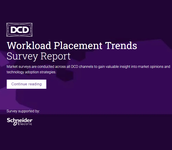There is no doubt that everyone involved in the business of data centers is facing both a unique set of challenges and opportunities. The rapid rise in data usage over the last 18 months, perhaps seen as a ‘blip’ as individuals and businesses hastened their acceptance and adoption of digital services, is now expected to continue unabated. Indeed, according to IDC, the amount of digital data created over the next five years will be greater than twice the amount of data created since the advent of digital storage.
Combined with increased focus on digital transformation strategies to deliver new revenue streams and provide services at the edge, demand for reliable and resilient data storage and digital infrastructure is clearly more important than ever.
Investors pile in
It should be of no surprise therefore that interest in the data center industry, as a profitable alternative investment option to more traditional real estate assets, is surging. This sector offers investors an opportunity to expand their portfolios in major cities around the world, whilst at the same time also considering investments outside of the core data center markets of Frankfurt, London, Amsterdam, Paris, and Dublin (FLAPD) which together currently have just under 3.5 gigawatts of live power.
Competition for available land in suitable locations is already fierce, and growing, and will continue to impact the price of potential sites for data center development. There is unfortunately no getting away from the fact that the lack of power in established metros will be a very real issue for businesses to consider in 2022.
For this reason, I expect to see a continued rise in ‘power banking’ next year as data center operators strive to guarantee access to power in the timeframes and locations needed. For instance Frankfurt has more phased power at over 550MW than live capacity which is just under 500MW. In parallel, there will also be a continued effort towards strategic site selection, moving away from the core markets to areas where the availability of power, over a long period, can be more realistically achieved.
Outside the hubs
DC Byte data shows that the sector is already starting to see developments landing outside of Frankfurt because of power constraints for data center operators in the city, with one hyperscaler acquiring three sites in Hanau, Erlensee and Dietzenbach in 2020. In Spain AWS took the decision to develop in Zaragoza, unlike other cloud providers which continued to focus on Madrid. AWS is now on course to go live with its first hyperscale campuses in the region this year.
Much of the growth we’ve witnessed in the Nordics has been in Sweden and Denmark which have become popular locations for enterprise hyperscale deployments. Stockholm is on track to become the market with the third largest capacity scheduled to go live in 2022, after Dublin and London. Half of the total self-build public cloud deployments across the Nordics are located in Denmark, even though the majority of large facilities are located outside Copenhagen on the Jutland peninsula.
Our research shows that the Nordic region is already anticipated to support 470MW from the major hyperscalers next year and the current live capacity in the Nordic metros of 549MW - which puts it ahead of Frankfurt and Paris - is also likely to attract attention.
Across EMEA, the most pressing issue for 2022 running alongside space and power could be skills and experience gaps that could jeopardise the medium-to-long-term future of the data center market. The trend for some in the current climate to embrace ‘The Great Resignation’ may not yet be top of the agenda in the data center industry. However, if a sufficiently large and skilled workforce of network and mechanical and electrical engineers are not recruited to service and support the sector, the digital infrastructure needed to deliver and maintain our digital lives will put under extreme pressure.




